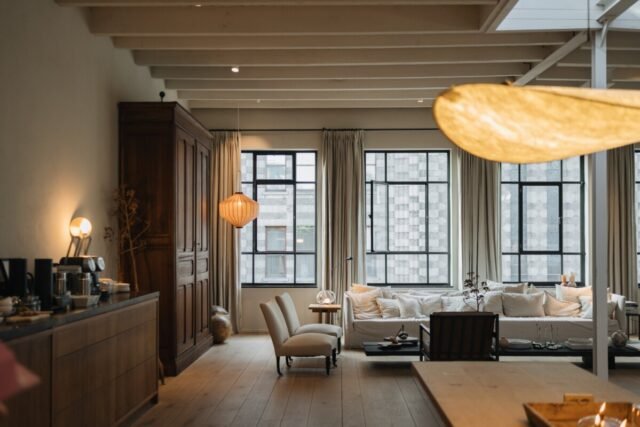Selecting the proper lighting for your home is key to creating an inviting and functional space. The right lighting can set the mood, make a design statement, and ensure your home is optimized for activities like reading, cooking, and entertaining. By understanding lighting fundamentals, choosing fixtures for specific rooms, and layering lighting effectively, you can design a lighting plan that enhances your home’s ambiance.
Understanding the Fundamentals of Home Lighting
When deciding on lighting for your home, it’s important to understand the three main types of lighting and how they work together to illuminate a space.
Ambient Lighting
Ambient lighting provides overall illumination to a room. It’s the base layer of light that enables you to move comfortably through the space. Ambient lighting is often accomplished with ceiling lights, chandeliers, pendant lights, and wall sconces. For most rooms, the goal is soft, uniform ambient lighting that avoids harsh shadows.
Task Lighting
As the name suggests, task lighting focuses light on specific work areas where you need extra illumination for activities like reading, cooking, grooming, and working on hobbies. Task lighting can be provided by portable lamps, under-cabinet lighting, track lighting, and recessed cans. Properly positioned task lighting prevents eye strain.
Accent Lighting
Accent lighting adds drama to a space by illuminating architectural details, artwork, collections, and decorative elements. Accent lighting creates visual interest in a room. Spotlights, picture lights, and directional lighting provide focused beams ideal for accent lighting.
In addition to type of light, you’ll also want to consider the color temperature and brightness.
Color Temperature
Color temperature is measured in Kelvins (K) on a scale from warm to cool. Lower Kelvin temperatures like 2700K-3000K produce a warm, cozy light. Neutral white light is between 3500K-4000K. Cooler color temperatures above 5000K create a more energizing vibe. Select bulbs based on the ambiance you want to achieve.
Brightness
Brightness is measured in lumens, indicating the total amount of light produced by a bulb or fixture. Match the lumens to the size of the room and its lighting needs. For example, brightly lit kitchens and bathrooms need 2000+ lumens while dim accent lights can be as low as 400 lumens.
By mixing lighting types and adjusting color and brightness, you can design a layered lighting plan tailored to your home.
Choosing Lighting for Specific Rooms
The lighting needs of every room depend on its size, functions, and aesthetic. Evaluate how each space will be used when selecting fixtures.
Living Room Lighting
Living rooms require a variety of lighting. For overall illumination, opt for layered ambient lighting from ceiling fixtures, lamps, and sconces. Make sure to have accessible wall switches or dimmers to adjust the lighting for both energetic gatherings and cozy nights in. Position adjustable task lighting next to seating areas to accommodate reading or hobbies. Use accent lighting on architectural details, artwork, shelves, and collections to add character.
Bedroom Lighting
Bedrooms demand both general and specific lighting. For overall illumination, ceiling lights and table lamps work well. Be sure to have variable controls from bright light for cleaning to dim mood lighting. Position adjustable bedside lamps to provide directed task lighting for reading without disturbing your partner. Relaxing accent lighting, such as wall sconces or cove lighting, creates a serene vibe.
Kitchen Lighting
Kitchen lighting must meet the demands of food preparation. Bright overhead lighting is ideal over workstations, while under-cabinet lighting illuminates countertops. Use pendant lights or recessed cans to provide ambient lighting for the whole kitchen. Task lighting under cabinets and over the sink facilitates cooking tasks. For dining areas, chandeliers, pendant lights or wall sconces allow you to adjust the brightness.
Bathroom Lighting
Bathroom lighting serves both function and ambiance. Bright overhead lighting is essential at vanities for grooming. Waterproof ceiling lights work well in showers and above bathtubs. Under vanity strip lighting illuminates legroom without shadows. Use accent lighting to create a spa-like environment with wall sconces or cove lighting.
Layering Lighting for a Balanced Effect
When designing your home’s lighting, it’s important to layer multiple types of lighting to create ambiance, meet functional needs, and provide visual interest. Follow these tips for layering lighting effectively:
- Combine overhead ambient lighting from fixtures like chandeliers or ceiling lights with portable lamps for flexible illumination.
- Flank windows with sconces or pendant lights to make the most of natural light.
- Use recessed and track lighting to spotlight artwork, collections, and architectural details.
- Install under-cabinet lighting along with pendant lights over work areas in kitchens.
- Place table and floor lamps in seating areas to provide adjustable task lighting for reading.
- Set matching bedside table lamps on both sides of the bed for reading comfort.
- Mix the color temperatures of bulbs, using warmer lights for ambiance and cooler lights for tasks.
- Control lights with dimmers, smart technology, and multiple switching zones for easy adjustments.
By thoughtfully combining varied lighting sources, you can create the perfect balance of illumination for both aesthetics and function.
Selecting Lighting Fixtures that Complement Your Style
Beyond function, lighting fixtures also serve as part of your home’s décor. Selecting styles and finishes that align with your interior design enhances the overall look of each room. Consider the following tips when choosing fixtures:
- For traditional décor, opt for elegant chandeliers, sconces, and table lamps in finishes like antique brass or crystal.
- Contemporary spaces shine with modern fixtures like linear pendants, track lighting, and LED strips.
- Rustic designs incorporate wrought iron, stained wood, and Edison bulb pendants and table lamps.
- Coastal decors look best with nautical-inspired fixtures featuring materials like woven rope, seashells, and weathered wood.
- Farmhouse lighting includes galvanized metal pendants, exposed Edison bulbs, and vintage-style filament lamps.
- Industrial interiors feature matte black or nickel pendant lights, cage lamps, and bare bulb fixtures.
- For glamorous spaces, choose sparkling crystal chandeliers, gilded sconces, and ornate table lamps.
Scale also matters when selecting fixtures. Make sure new lighting is proportionate to your ceiling height and furniture. An interior designer can help you choose fixtures that complement your décor.
Energy Efficient and Sustainable Lighting Solutions
When upgrading your home’s lighting, it’s wise to invest in energy-efficient options that will save on electricity costs and reduce environmental impact. Here are some solutions to consider:
- LED bulbs last 10-25 times longer than incandescents and use at least 75% less energy, making them the top choice.
- Look for ENERGY STAR rated fixtures which meet strict energy efficiency guidelines set by the EPA.
- Install dimmers, timers, motion sensors, and smart lighting controls to further cut electricity use.
- Choose fixtures made from sustainable materials like recycled metal, FSC-certified wood, and natural fiber shades.
- Dispose of old bulbs properly to keep mercury out of landfills. Many retailers recycle CFLs and fluorescent tubes.
By selecting efficient and eco-friendly lighting, you can reduce your home’s carbon footprint and lower your utility bills while still enjoying beautiful illumination. Consult with electricians and lighting designers to plan upgrades tailored to your needs and lifestyle.
Conclusion
The lighting in your home has a profound impact on how each space looks, feels, and functions. By understanding fundamental lighting concepts and carefully choosing fixtures suited to your decor and activities, you can craft lighting that elevates your home’s design and creates the perfect ambiance for relaxation or entertaining. Planning your lighting room-by-room and layering multiple sources allows you to balance both practical needs and aesthetic appeal. Taking advantage of energy-efficient options also allows you to cut costs and reduce environmental impact. With the right lighting design, you can make every part of your home more inviting and comfortable while reflecting your personal style.































